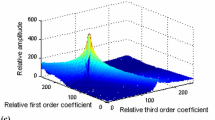Abstract
Motion compensation based on the parameter estimation of a moving target has a strong influence on the inverse synthetic aperture radar (ISAR) imaging quality. For the target with built-in disturbance components or under an extremely low signal-to-noise ratio (SNR), conventional parameter estimation methods based on cross-correlation processing of adjacent profiles, such as the cross-correlation method and the accumulated cross-correlation method, give sizable aligned errors and subsequently produce low-quality ISAR images. The fractional Fourier transform is capable of concentrating the signal power; however, a large computational complexity is induced by searching the matched order. In view of the problems above, a time-weighting symmetric accumulated cross-correlation method is proposed herein. This method maps the spectrum of the range profile into a single-peak envelope to reduce range alignment errors, and presents a symmetric accumulated manner to offset the accumulated error. The simulation results demonstrate that the proposed method yields much better estimation precision than other methods, and yields extremely low computational complexity.
Similar content being viewed by others
References
C. A. Willy. Synthetic aperture radars [J]. IEEE Transactions on Aerospace and Electronic Systems, 1985, AES-21(3): 440–443.
D. J. Klass. Inverse synthetic aperture technology aids radar identification of ships [J]. AviationWeek and Space Technology, 1987, 10(127).
J. L. Walker. Range-Doppler imaging of rotating objects [J]. IEEE Transactions on Aerospace and Electronic Systems, 1980, 16(1): 23–52.
H. Wu, D. Grenier, G. Y. Delisle, et al. Translational motion compensation in ISAR image processing [J]. IEEE Transactions on Image Processing, 1995, 4(11): 1561–1571.
S. Y. Shin, N. H. Myung. The application of motion compensation of ISAR image for a moving target in radar target recognition [J]. Microwave and Optical Technology Letters, 2008, 50(6): 1673–1678.
C. C. Chen, H. C. Andrews. Target-motion-induced radar imaging [J]. IEEE Transactions on Aerospace and Electronic Systems, 1980, AES-16(1): 2–14.
A. D. Zhu, X. Q. WU. Range-Doppler imaging and multiple scatterpoint location [J]. Journal of Nanjing Aeronautical Institute, 1991, 23: 62–69.
T. Itoh, H. Sueda, Y. Watanabe. Motion compensation for ISAR via centroid tracking [J]. IEEE Transactions on Aerospace and Electronic Systems, 1996, 32(3): 1191–1197.
J. S. Cho, D. J. Kim, D. J. Park. Robust centroid target tracker based on new distance features in cluttered image sequences [J]. Visual Communications & Image Processing, 2000, 4067 (12): 1045–1056.
B. Haywood, R. J. Evans. Motion compensation for ISAR imaging [C]//Proceedings of Australian Symposium on Signal Processing and Applications, Adelaide, 1989: 112–117.
M. J. Liu, M. G. Gao, X. J. Fu. A novel range alignment algorithm for real time ISAR imaging [C]//Proceedings of International Conference on Signal Processing, Beijing, 2006.
E. Sejdic, I. Djurovic, L. Stankovic. Fractional Fourier transform as a signal processing tool: an overview of recent developments [J]. Signal Processing, 2011, 91(6): 1351–1369.
R. Tao, B. Deng, Y. Wang. Research progress of the fractional Fourier transform in signal processing [J]. Science in China Series FInformation Sciences, 2006, 49(1): 1–25.
J. Y. Xue, L. Huang. An improved cross-correlation approach to parameter estimation based on fractional Fourier transform for ISAR motion compensation [C]//Proceedings of IEEE International Conference on Acoustics, Speech and Signal Processing (ICASSP), Brisbane, 2015: 1538–1542.
W. S. Cleveland. Robust locally weighted regression and smoothing scatterplots [J]. Journal of the American Statistical Association, 1979, 74(368): 829–836.
Author information
Authors and Affiliations
Corresponding author
Additional information
This work is supported in part by the National Science Foundation for the Distinguished Young Scholars of China (No. 61525103), and the Shenzhen Fundamental Research Project (No. JCYJ20150930150304185).
Jiayin Xue received her B.E. and M.E. degrees from Harbin Institute of Technology, China, in 2007 and 2012 respectively. She is now a Ph.D. candidate of electronic and information engineering in Harbin Institute of Technology Shenzhen Graduate School. Her research interests include ISAR image processing and array signal processing. (Email: xuejiayin@ stu.hit.edu.cn)
Xiao Han received his M.E. degree from Harbin Institute of Technology Shenzhen Graduate School, China, in 2014. He is now a Ph.D. candidate of electronic and information engineering in Harbin Institute of Technology Shenzhen Graduate School. His research interests include wireless signal processing and UAV intelligent control. (Email: hanxiao5562@stu.hit.edu.cn)
Lirong An received her M.E. degree from Harbin Institute of Technology Shenzhen Graduate School, China, in 2012. She is now an assistant experimentalist of the Key Laboratory of Network Oriented Intelligent Computation in Harbin Institute of Technology Shenzhen Graduate School. Her research interests include EtherCAT protocol, and communication signal processing.
Qinyu Zhang [corresponding author] received his B.E. degree from Harbin Institute of Technology in 1994, and the Ph.D. degree from the University of Tokushima, Japan, in 2003. He has been a full professor since 2005 at HIT Shenzhen Graduate School, and was awarded the National Science Fund for the Distinguished Young Scholars in 2015. His research interests include aerospace communications and networks, wireless communications and networks, cognitive radios, signal processing and biomedical engineering. (Email: zqy@hit.edu.cn)
Rights and permissions
About this article
Cite this article
Xue, J., Han, X., An, L. et al. Time-Weighting Symmetric Accumulated Cross-Correlation Method of Parameter Estimation. J. Commun. Inf. Netw. 3, 53–60 (2018). https://doi.org/10.1007/s41650-018-0007-4
Received:
Accepted:
Published:
Issue Date:
DOI: https://doi.org/10.1007/s41650-018-0007-4




